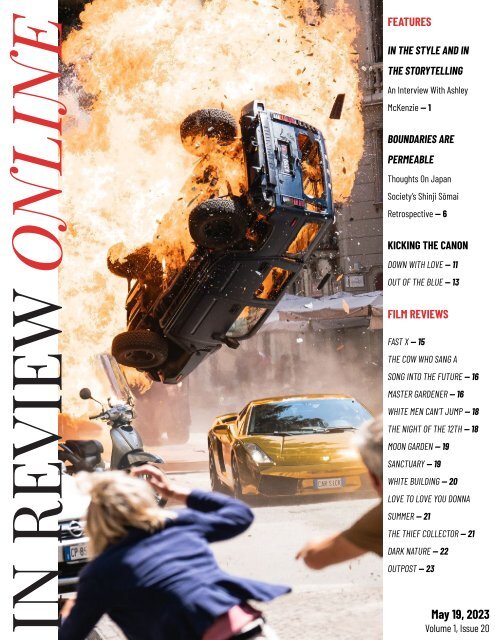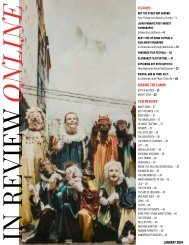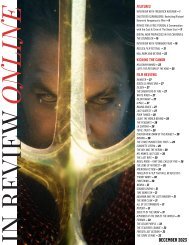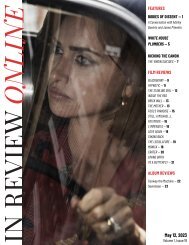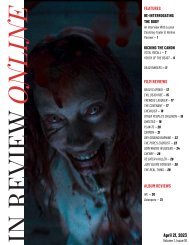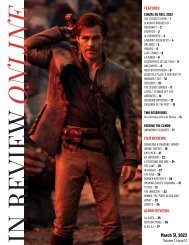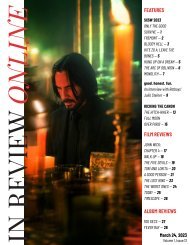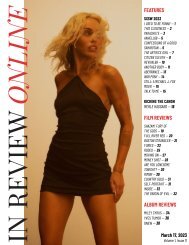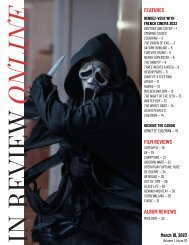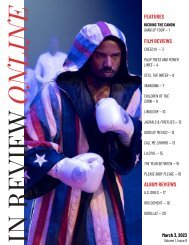InRO Weekly — Volume 1, Issue 20
- No tags were found...
Create successful ePaper yourself
Turn your PDF publications into a flip-book with our unique Google optimized e-Paper software.
IN REVIEW ONLINE<br />
FEATURES<br />
IN THE STYLE AND IN<br />
THE STORYTELLING<br />
An Interview With Ashley<br />
McKenzie <strong>—</strong> 1<br />
BOUNDARIES ARE<br />
PERMEABLE<br />
Thoughts On Japan<br />
Society’s Shinji Sōmai<br />
Retrospective <strong>—</strong> 6<br />
KICKING THE CANON<br />
DOWN WITH LOVE <strong>—</strong> 11<br />
OUT OF THE BLUE <strong>—</strong> 13<br />
FILM REVIEWS<br />
FAST X <strong>—</strong> 15<br />
THE COW WHO SANG A<br />
SONG INTO THE FUTURE <strong>—</strong> 16<br />
MASTER GARDENER <strong>—</strong> 16<br />
WHITE MEN CAN’T JUMP <strong>—</strong> 18<br />
THE NIGHT OF THE 12TH <strong>—</strong> 18<br />
MOON GARDEN <strong>—</strong> 19<br />
SANCTUARY <strong>—</strong> 19<br />
WHITE BUILDING <strong>—</strong> <strong>20</strong><br />
LOVE TO LOVE YOU DONNA<br />
SUMMER <strong>—</strong> 21<br />
THE THIEF COLLECTOR <strong>—</strong> 21<br />
DARK NATURE <strong>—</strong> 22<br />
OUTPOST <strong>—</strong> 23<br />
May 19, <strong>20</strong>23<br />
<strong>Volume</strong> 1, <strong>Issue</strong> <strong>20</strong>
IN THE STYLE AND<br />
IN THE STORYTELLING<br />
An Interview With<br />
Ashley McKenzie<br />
One of the highlights of the <strong>20</strong>22 Berlinale’s Encounters sidebar was Ashley McKenzie’s Queens of<br />
the Qing Dynasty. Following the Canadian filmmaker’s first feature, Werewolf, Queens tracks the<br />
friendship between Star (Sarah Walker), a young neurodiverse woman entering adulthood, and An<br />
(Ziyin Zheng), a hospital volunteer who’s assigned to monitor her after a suicide attempt. Working<br />
in tandem with Walker and Zheng’s extraordinary performances, McKenzie creates a rhythm that<br />
is both regulated and disorienting, and one which keenly reflects Star’s state of mind. We caught<br />
up with McKenzie earlier this month following the film’s New York release.<br />
1
Let's start at the beginning of [Queens of the Qing Dynasty].<br />
The whole movie is tackling a lot of difficult subject matter,<br />
but it often feels like a very tender film, whereas those first<br />
few minutes feel much harsher <strong>—</strong> obviously because of what<br />
is happening, but also just in the way that the film is visually<br />
introducing you to Star. It's very striking, but it also feels like<br />
a risk. Why did that feel like the place the film needed to<br />
start?<br />
I'm trying to think back to the beginning, and if there was a very<br />
specific moment when I felt like the film needed to enter in that<br />
way. I mean, I think my overall feeling is that I wanted to show<br />
that Star is an at-risk person, and that the stakes are kind of<br />
high and it is life or death. And I think I needed to show that at<br />
the beginning because, in a lot of ways, her attitude toward the<br />
barriers and challenges she's facing in her life, in this particular<br />
moment, and this crossroads and aging out of foster care, can<br />
be fairly optimistic at times, and can tend to focus on the<br />
positive of what's immediately in front of her and things like<br />
that. So sometimes, I think if we're really in her world, we can<br />
forget that dangerous things and bad things have happened.<br />
And having that vulnerability come out <strong>—</strong> to me, her ingesting<br />
poison is a cry for help. And starting the film that way I think<br />
brings people in on that note, but then also leaves the question<br />
open of whether the institutional model of care is going to be<br />
able to actually address that, or if something else can. So I think<br />
that's the main thing: wanting to lay things pretty bare. And I<br />
think that's true with having like this little glimpse of her in the<br />
shower as well. Just feeling that vulnerability.<br />
The film has two lead characters, and one of the actors has<br />
a script credit. I know you developed that character with<br />
them, and I know Star is also based on a real person. So<br />
what was the casting process like for that role?<br />
I will note that my work with Ziyin on the script was more of a<br />
consulting process, not like a co-writing process. I decided to<br />
rewrite the script as I had written it for them as a person, and I<br />
wanted to explore their personal experiences and let them bring<br />
experiences that I felt I didn't have an understanding of in as<br />
specific a way as I needed to tell that story. So that was why I<br />
involved Ziyin as a script consultant.<br />
And then we moved into doing an audition process to see how it<br />
would all come together on camera. But in some ways, I kind of<br />
approached things initially similarly with the character of Star<br />
because she's loosely based on a friend of mine. Years before<br />
even writing the script, I met her in the casting process of my<br />
last feature, Werewolf. And I just thought she was a really<br />
creative person, I really liked pictures that I saw that she would<br />
take with her phone and post online. And I just thought she had a<br />
really interesting eye and way of observing things. So I had<br />
connected with her and tried to figure out if we could make a<br />
film together, like a short film, or a documentary, where we<br />
would've been co-authoring things. But anytime I tried to<br />
introduce the idea of a project, it seemed like it made our<br />
friendship stressful. So I just decided that I wasn't going to try to<br />
collaborate with her on an art thing, that we would just be really<br />
good friends, and we continue to be great friends. And that's just<br />
worked best for both of us.<br />
So I was intimidated by having to cast an actor because I could<br />
hear Star’s voice in my head in such a clear way, and it was tied<br />
in many ways to the cadence in which my friend speaks. But I<br />
just did a traditional casting process, which in my community<br />
doesn't mean that I got a casting agent and stuff like that; it<br />
means that I just reached out to people in the theater<br />
community. I mean, I did audition some professional actors that<br />
had film experience and did a few tapes. I was also just keeping<br />
my eyes open anywhere in my community.<br />
But it was a call that we put out to the youth in the theater<br />
community that ended up leading to finding Sarah Walker. And<br />
she was the second person that came into the audition, and she<br />
had only read the audition scene. When she played it, right off<br />
the top she was really in the register and tone of how I heard<br />
Star in my mind as I was writing. So there was just something<br />
that clicked right away. Everything else about her as a person on<br />
paper seemed completely unlike Star, so I was a little bit unsure.<br />
I was like, was that just like a lucky audition? So I kept doing<br />
more additions for a couple months. And I kept calling Sarah<br />
Walker back to do a few more auditions, and eventually settled<br />
on casting her. And once we were on set, she just dialed in the<br />
character to such a perfectly precise degree that I really never<br />
imagined I could get without casting, say, someone like my<br />
friend <strong>—</strong> or even then, I don't even know if that could have<br />
2
materialized in the way that I imagined. But Sarah really brought<br />
it to life in a way that was so exciting to me.<br />
It's rare to see a film in which the dialogue and the visual<br />
style are both so specific, and also work so well together.<br />
How did you develop those two elements of the film?<br />
I think it probably has to do with, you know, a couple of things.<br />
One thing I suppose is I'm usually compelled to tell a story<br />
because of things, people, events, or locations that I encounter<br />
in my real life, like very specific things. And, you know, I'm not<br />
sitting down to write, thinking, “I want to write a character who's<br />
aging out of foster care,” or “I want to write a character who's<br />
moving from Shanghai to Canada.” I never start in that place. And<br />
I could see if I was starting writing there, how I could maybe<br />
start to lean on some clichés, or maybe I just wouldn't go deep<br />
enough to get the nuances in there.<br />
I usually am starting on the ground, mixed into the textures of it<br />
all, whether it's meeting a specific person who wears their<br />
clothes this way or speaks this way or sings this particular way<br />
or, you know, has an interest in Queens of ancient China. I'm very<br />
much a detail person, and it's those textures that kind of excite<br />
me. And usually that's the stuff I start to work with, and then I<br />
build out from there. So, I don't know, I think it's almost like I'm<br />
starting more on the granular level. And then it's more just trying<br />
to figure out if I can build it out to be something that is a story<br />
worth telling. And that's maybe when I know that it's gonna be my<br />
next film, when enough textures and details and things have<br />
coalesced into something and are there to warrant a story that's<br />
worth putting on the screen. I think that some sort of bottom-up<br />
approach is an important part of my process.<br />
And then the other thing that really defines the characters or the<br />
dialogue, style, these sorts of things, is just me trying to stay<br />
true to my instincts as much as possible. And because you could<br />
define the way I'm making films as being in isolation <strong>—</strong> you know,<br />
I'm not totally isolated, but I am on an island far removed from a<br />
traditional film industry, [working] with a super small team, and<br />
[I] end up having to wear a lot of hats and do a lot of roles<br />
myself. So in doing that, I spend a lot of time working alone, or<br />
working with a few close collaborators where there's not a lot of<br />
having to filter my ideas through other people, or<br />
justify my ideas to other people, and have them potentially<br />
watered down or questioned.<br />
Of course, in the collaboration process, we're all trying to find the<br />
best way to tell the story, and things do shift. And there are really<br />
amazing collaborators on this film that took it to places I never<br />
could have on my own. But I think the scale on which I'm<br />
working, I think the the degree of removal of where I choose to<br />
live my life and where I choose to make my films, ends up<br />
leading to being really instinctual, really intuitive, and really<br />
working the material in ways [where] I kind of just commit to<br />
things that feel right, even if they might not be conventional. If I<br />
was in a different setting, I could imagine that I might really<br />
doubt myself. But I think I do try to honor those impulses, and I<br />
think it does lead to a different cumulative effect on the style.<br />
And the dialogue is also a bit more of my personality, and my<br />
love of being silly and playing with language and little things like<br />
that [which] came out in this film that didn't really surface in<br />
some of my other work.<br />
Another thing that struck me stylistically is the way you<br />
visually express point of view. Going back to that first scene<br />
<strong>—</strong> Star’s point of view is set up very clearly in the way she<br />
looks at the medical staff. How did you think about shooting<br />
the points of view of these types of characters who we don’t<br />
often see in films?<br />
I think a big thing… specifically with point of view, but also just<br />
the basic mechanics of film grammar, is that I like to shoot the<br />
characters in single shots when I can, because I just want them<br />
to be interfacing with one another. To me, that's so much of what<br />
the film is about, and the way I like to move through the world is<br />
really connecting with people. And I don't want an<br />
over-the-shoulder shot where you see a bit of the other person<br />
or have that sort of dirty frame, they call it, I think. So in just the<br />
building blocks of the film, there are a lot of medium close-ups<br />
that are moving back and forth, and that to me was really in<br />
single shots, and there's very few two shots in the film. That felt<br />
right for two characters that are coming from very different<br />
places, but trying to not interfere with what energy is moving<br />
between the two of them.<br />
And when it comes to point of view, I think I'm thinking more<br />
3
subjectively, and that makes me think more of sounds in some<br />
ways. That's where I was trying to sort of tease out a bit more of<br />
an internal landscape or process, I guess. But I do also focus on<br />
props and details a fair bit, too. And so that's a little difference in<br />
terms of point of view <strong>—</strong> that is definitely more of an authorial<br />
point of view. And that's something I've always done in my work<br />
as a way to focus on things that I think can be graphical<br />
elements that can become part of the story [and] can help me<br />
tell the story. I think that's there as well.<br />
It's become almost a cliché that modern directors make<br />
period pieces because they're afraid to engage with what's<br />
going on now, and that's not at all the case with your film,<br />
which really embraces technology and social media as well<br />
as things like the fluidity of social identity. Did it feel<br />
intimidating to do that or was it more natural?<br />
I would say it probably feels more natural to me. I mean, I am<br />
aware of this feeling that I'm in this, again, island mentality or<br />
landscape, and that maybe what is timely here is not timely in<br />
other places <strong>—</strong> often things land here a bit later. So that is one<br />
thing that comes into my mind, and in some ways the film is<br />
trying to explore that… in contemporary times, especially in<br />
social media and information sharing and that culture that<br />
exists. You know, when I unplug from that and I'm just on the<br />
ground in my community, I can feel like they're very different<br />
worlds happening almost in different times. So that is something<br />
that isn't a discomfort, but I think was an interesting thing to be<br />
aware of while I was making the film.<br />
And yeah, in terms of, say, working with certain visual elements<br />
that are very much of our time, I think as long as I'm doing it in a<br />
way, whether it's like texting or a logo or social media platform,<br />
as long as I'm doing it in a way that feels honest to me and I can<br />
find a way to do it that feels cinematic and aesthetically<br />
interesting, then I don't feel deterred to tell that story. I think it's<br />
interesting. And maybe it would entail more research if I was<br />
trying to tell a story at a time that wasn't what I'm steeped in. It<br />
is exciting, that there is a challenge in it. Do we have time to<br />
really reflect on things? Things do feel like they're shifting daily.<br />
But yeah, I think with this film, I felt like I was in my own world<br />
with the two characters, writing, and they were like my best<br />
friends for years. And then I was editing the film for a long time<br />
during Covid, and I just felt like I was in my own bubble with Star<br />
and An. And that felt like a happy place for me to be.<br />
It's interesting that you say that you feel like the community<br />
that you're in is sometimes kind of behind other places,<br />
4
ecause I feel like the film is, if anything, ahead of where I<br />
see things culturally, even being in a huge city.<br />
Oh, I like that, and hopefully, yeah, the film can have that effect.<br />
That's great for me to hear because the film is trying to look at<br />
things from a different perspective, I guess, and sort of question<br />
some of these notions that we have about ourselves, or that we<br />
have of other people. And hopefully in the filmmaking, and in the<br />
style, and in the storytelling, it does turn some of those things on<br />
their head.<br />
I know you were in New York this weekend, and we're talking<br />
right now even though the movie premiered over a year ago.<br />
I know that's not uncommon for films going through the<br />
festival ecosystem, but how does it feel to not only sit with<br />
the completed film, but sit with audience reactions for that<br />
long?<br />
It's definitely on my mind, I think probably because I'm feeling<br />
like I'm coming to the end of my marathon race <strong>—</strong> my legs are a<br />
bit rubbery. And yeah, I've questioned: what's the best way to<br />
release a film? And it can be nice to have it all happen in a more<br />
condensed timeline so that all the energy<br />
is moving it toward this bigger release.<br />
But then, I don't know; I would say with<br />
both Werewolf and Queens I've had a bit<br />
more of this traditional platform sort of<br />
a release <strong>—</strong> done the festival circuit and<br />
then done some theatrical runs. And<br />
there's been something nice about the<br />
slow burn sort of process, too, because<br />
it doesn't just come and go in a blip. It<br />
does allow the film to remain in<br />
consciousness and in conversation for<br />
a period of time, which I think is actually<br />
quite nice. And so much of what the film<br />
is trying to do and what I wanted to do is<br />
to open communication and to find how<br />
we can move through little idiosyncrasies<br />
and bumps and discomforts and continue<br />
to have a conversation as people. So I<br />
think there is something nice about<br />
having this longer conversation that I’m<br />
beginning to appreciate more as I kind of look back at the<br />
different ways of sharing a film with the world.<br />
And I think for me, again, because I'm someone who is very<br />
curious about other humans and likes to meet other people <strong>—</strong><br />
and be outside my own little bubble of a life <strong>—</strong> when I do attend<br />
screenings and do talkbacks and travel to different places, it<br />
does allow me to meet people that I wouldn't meet otherwise.<br />
And that's another thing I've come to realize: when I think, “I don't<br />
know if I should keep traveling with the film,” but then I have<br />
these connections or these conversations and I learn a lot and I<br />
meet interesting people. And it's almost like, to me, it seems this<br />
is meant to be, this is a very fortuitous way for me to have a<br />
reason to talk to someone new. And that is what the film was<br />
about and what I love, moving through life. So I have been<br />
reminding myself, as I get tired, that each time I show the film<br />
somewhere and go there with it, that it's giving me this really<br />
cool opportunity to be able to start a conversation with someone<br />
that I would have no basis on which to get to know them<br />
otherwise. That's a fun part of being a filmmaker that I<br />
appreciate. <strong>—</strong> INTERVIEW CONDUCTED BY JESSE CATHERINE<br />
WEBBER<br />
5
BOUNDARIES ARE PERMEABLE<br />
Thoughts On Japan Society’s Shinji Sōmai Retrospective<br />
A high-angle shot of a yakuza and his girlfriend continues following the woman overhead as she crosses a street to a school<br />
swimming pool. The camera then passes over the pool’s fence and lands on portly bully Deguchi, who calls out from atop a diving<br />
board, “I have an important announcement! You all suck!” The camera descends and tracks around the pool as Deguchi and his<br />
cohorts continue to taunt their classmates, until the off-screen sound of motorcycle engines pulls attention to the neighboring school<br />
courtyard, where a group of rebellious students circle an overmatched teacher on motor scooters. The bullies join in the fun, until<br />
finally three of their victims confront Deguchi with the promise of revenge. Suddenly, the yakuza seen in the earlier shot enters<br />
through the school gate and accosts Deguchi, just before a car pulls up [from behind him], and chief bully is yanked through the<br />
window with a fishing net. The rest of the kids, and the camera, chase after the car as it speeds away, at which point one kid turns to<br />
the others and asks, “Was… that a kidnapping?”<br />
This is the opening scene of Shinji Sômai’s 1983 P.P. Rider, and it’s staged almost entirely in one take (save for a brief insert when<br />
Deguchi is pulled into the car). It’s about the most concise introduction to Sômai’s cinema that one could ask for: the two elements<br />
with which he’s most commonly associated <strong>—</strong> a focus on children and dazzling long takes <strong>—</strong> are both there, as are mixtures of<br />
deadpan humor and an ever-present specter of violence, an alternately cruel and hapless adult presence, and even the motif of water<br />
that runs through much of his work. More than anything, this rich, single-shot encapsulation of a distinctive milieu proves that the<br />
filmmaker’s staggering formal dexterity works in perfect concert with a wide-open, minutely detailed film-world.<br />
Massively influential in Japan, but still relatively unknown here, Sômai’s work has called out for broader appreciation for decades now,<br />
ever since his untimely death in <strong>20</strong>01, at the age of 53. Luckily, New York’s Japan Society has taken the first step with their<br />
triumphant new series, Rites of Passage (which just ran from April 28 to May 13), the director’s first-ever North American<br />
6
Retrospective. Focusing primarily on Sômai’s prolific 1980s run,<br />
the series reveals the filmmaker to be one of the most original<br />
and accomplished filmmakers working anywhere in the world<br />
during that time.<br />
Sômai’s career began as an assistant director for Nikkatsu<br />
Corporation in 1972, working at first as an assistant director on<br />
the studio’s series of softcore Roman Pornos, and later under<br />
director Kazuhiko Hasegawa on his films The Youth Killer (1976)<br />
and The Man Who Stole the Sun (1979). Sômai made his debut as a<br />
director in his own right with The Terrible Couple (1980), and<br />
broke through commercially with the iconic (in Japan) yakuza<br />
satire Sailor Suit and Machine Gun (1981). He would go on to create<br />
a body of work that readers of Japan’s highly influential Kinema<br />
Junpo magazine named the best of the 1980s in a poll. That may<br />
seem like faint praise, given the “lost decade” tag that’s long<br />
been attached to the country’s films of the ‘80s, after the<br />
traditional studio system had largely collapsed and international<br />
interest in Japanese cinema waned. But aside from the general<br />
unfairness of that whole term <strong>—</strong> which ignores essential<br />
contributions from emerging directors like Gakuryu Ishii,<br />
Toshiharu Ikeda, Juzo Itami, and Nobuhiko Obayashi, among<br />
others <strong>—</strong> Sômai’s neglect at the hands of the international<br />
cinema establishment is also symptomatic of that<br />
establishment’s tendency not to take seriously any work which<br />
doesn’t seem to take itself too seriously. And Sômai’s certainly<br />
don’t; his films are often deeply funny and highly entertaining,<br />
with hardly a ponderous note among them. But that’s never<br />
stifled the brazen, utterly singular personal expression of<br />
Sômai’s filmmaking, even despite ostensibly working under the<br />
auspices of a commercial studio system.<br />
With time comes clarity, and now we have the privilege of<br />
enjoying Sômai’s work on its own terms. The two earliest films in<br />
Japan Society’s series, Sailor Suit and P.P. Rider, are also among<br />
his greatest, both bravura formal achievements that highlight his<br />
daring sensibilities of genre and tone. They start from irresistible<br />
premises: in Sailor Suit, a teenage girl inherits her father’s<br />
yakuza clan, while P.P. Rider follows the classmates of the<br />
kidnapped bully, who resolve to save the bad seed… so that<br />
7
they can kill him themselves. The collision of<br />
children with the world of the yakuza is the<br />
perfect Sômai dichotomy: while his films<br />
proceed with all the guilelessness and<br />
possibility of youth,they do so in the shadow of<br />
a violent, unstable world, one that acts as a<br />
catalyst for the young characters’ awakening to<br />
adulthood. But where these movies become<br />
truly special is how this conflict is borne out in<br />
their formal strategies: long, roving takes<br />
simultaneously give the feeling of<br />
unconstrained, almost childlike discovery (one<br />
never knows what may lie in Sômai’s offscreen<br />
space), while grounding things in a real<br />
environment and geography, a sense of<br />
concrete physical presence underlining the<br />
director’s wildly imaginative fictions. It’s<br />
magical realism in its purest form <strong>—</strong> shots so<br />
often feel like magic tricks, precisely because<br />
they refuse to leave reality behind.<br />
Also key to the upside-down feeling of<br />
Sômai-world is the constant flipping of power<br />
dynamics between children and adults. An early<br />
image in Sailor Suit shows an army of<br />
black-clad yakuza bowing in deference to<br />
teenage protagonist Izumi (Hiroko<br />
Yakushimaru) outside her school’s playground;<br />
as if that’s not enough, after she reluctantly<br />
goes with them, we find out that the clan she<br />
now leads is actually comprised of only four<br />
buffoonish members <strong>—</strong> the rest were hired<br />
actors. Immediately after the kidnapping in P.P. Rider, the<br />
gangsters realize they have the wrong kid, and the lone adult<br />
helping our heroes find him (Mr. Gombei, aka “Nobody”) is hardly<br />
any more competent.<br />
None of this is to say that Sômai romanticizes his young<br />
protagonists <strong>—</strong> children are just as capable of violence and<br />
cruelty as anyone else in his films <strong>—</strong> but it’s not hard to see<br />
where the sympathies of his curious, skewed perspective lie.<br />
Sailor Suit’s Izumi variously plays the role of boss, friend, mother,<br />
and even potential romantic partner to her four lackeys, and<br />
while she emerges as the most moral and dignified character in<br />
the film, Sômai refuses to make her some sort of idealized<br />
heroine. That the film’s suggestive title and poster image is a bit<br />
misleading and taken from only a few brief seconds of time on<br />
screen <strong>—</strong> during a sequence that suggests Izumi’s total<br />
corruption by the larger forces of the world <strong>—</strong> serves as an<br />
effective summary of Sômai’s relationship to his films’<br />
commercial demands. Fortunately, in this case, the director was<br />
able to have it both ways <strong>—</strong> Sailor Suit and Machine Gun was still a<br />
major box office success in Japan, and even spawned two TV<br />
series and a legacy sequel.<br />
8
A similar dynamic resurfaces in 1985’s Typhoon Club, a classic in<br />
the Japanese youth genre that nearly shuts out the adults<br />
entirely, focusing on a group of children waiting out a typhoon<br />
overnight in their abandoned school. With parents out of the<br />
picture, the children all gang up on their cynical, put-upon<br />
teacher, onto whom they pour all their dissatisfaction with the<br />
adult world. Over and over again, Sômai’s incredibly charged<br />
images build out his world into mythic proportions, only to bring<br />
his characters back down to earth with as little as a single hard<br />
cut. At the film’s climax, one young character’s existential crisis<br />
culminates in him giving up on humanity and throwing himself<br />
out of a school window <strong>—</strong> smash cut to the exterior of the<br />
school, where his legs poke straight up through the jetsam that<br />
broke his fall. It’s the most Keatonesque image in a filmography<br />
that frequently evokes the silent comedian’s athletic yet<br />
underplayed slapstick, and a split-second crystallization of the<br />
director’s fearless mashing of tones.<br />
Typhoon Club, while slightly more aesthetically reserved than its<br />
predecessors, similarly gives the impression of a heavily stylized<br />
world that was set in motion long before the film began <strong>—</strong><br />
Sômai’s camera acting almost as an objective observer. Like the<br />
other 1985 Sômai film that features in Japan Society’s series <strong>—</strong><br />
Love Hotel, a return to his Roman Porno roots <strong>—</strong> Typhoon Club<br />
shows how Sômai used his signature long takes to astonishingly<br />
varied ends. Both films feature scenes in which the director<br />
simply locks the camera down and forces us to watch protracted<br />
moments of attempted sexual assault, shots as intense and<br />
sobering as some of his others are riotously entertaining. (On the<br />
other end of the spectrum, a third [!] 1985 film from Sômai, Lost<br />
Chapter of Snow: Passion [not screening in the retrospective],<br />
opens with a highly mobile, soundstage-bound 14-minute [!!]<br />
tracking shot that traverses space and time in charting the<br />
tragic childhood of its orphan-girl protagonist.)<br />
These scenes play into another of Sômai’s key themes: the<br />
impossible position of women in Japanese society. The<br />
confluence of subject and style evokes none less than Japan’s<br />
greatest filmmaker, Kenji Mizoguchi, whose long takes also<br />
afforded his female characters a certain grace denied to them<br />
by the surrounding world. Many of Sômai’s more adult-centric<br />
films revolve around this idea, from the study of masculine<br />
patriarchy on the high seas in The Catch (1983) to Love Hotel’s<br />
fraught, harshly transactional take on the pinku genre. Likewise,<br />
the two latest films in this series, Luminous Woman (1987) and<br />
Tokyo Heaven (1990), feature storylines centering on women <strong>—</strong> in<br />
this case, women attempting to escape predatory showbiz<br />
managers, which makes for an especially interesting subject in<br />
light of Sômai’s penchant for casting idol singers in leading<br />
roles.<br />
Luminous Woman leans into the more Felliniesque elements of<br />
Sômai’s mise-en-scene, specifically recalling La Strada in its tale<br />
of a hulking wrestler and a mistreated young singer navigating a<br />
surreal underworld. Tokyo Heaven, by contrast, has perhaps the<br />
most confectionary pop sensibility of any of Sômai’s films<br />
(despite being, along with Typhoon Club, one of his two entirely<br />
independently-financed works). It remains one of his most<br />
undervalued gems. The plot <strong>—</strong> an aspiring “campaign idol” is hit<br />
by a car and killed while running from her lecherous manager,<br />
only to return to Earth and take up residence with said<br />
manager’s underling, who had been tasked with covering up her<br />
death <strong>—</strong> would feel at home in a supernatural studio romance of<br />
the ‘40s (Portrait of Jennie, A Matter of Life and Death, etc). And<br />
while the narrative progresses more or less along the expected<br />
lines, the movie is so packed with inventive staging, oddball<br />
details, and unforgettable images that any trace of roteness falls<br />
away, genre framework serving as a foundation for, rather than a<br />
restriction on, the filmmaker’s imagination.<br />
Recommending Sômai’s films in part due to their long takes is an<br />
interesting proposition, as the idea of the long take itself has<br />
become something of a point of controversy in cinephilic<br />
discourse over the past decade. Countless recent acclaimed<br />
films and filmmakers have adopted the method as little more<br />
than proof of their own capability in marshaling talent and<br />
resources, monuments to technical ambition that fulfill only the<br />
most superficial understanding of what constitutes Great<br />
Directing. While Sômai’s camera movements can often match<br />
any of these for pure balleticism <strong>—</strong> it’s not hard to imagine why,<br />
as his mentor Kazuhiko Hasegawa claimed, his films frequently<br />
went well over budget <strong>—</strong> what stands out most is how<br />
fundamentally generous they are toward his performers. The<br />
intensely physical performances that Sômai gets from his actors<br />
work in perfect concert with how the director goes about<br />
capturing them; they’re constantly running, crawling, climbing,<br />
9
fighting, barreling their way through his turbulent worlds, and the<br />
camera makes space for them at every turn. When Luminous<br />
Woman’s wrestler wants to take in Tokyo for the first time, at the<br />
start of the film, he simply climbs out the window and onto the<br />
roof of the car he’s in, as it’s driving. In Tokyo Heaven, a man lives<br />
above his girlfriend (who he summons upstairs by blowing his<br />
trumpet), and the camera intricately tracks the movements up,<br />
down, and around the building. To Sômai, the physical limitations<br />
of the world always seem conquerable for his characters, and<br />
that starts with how his camera approaches those same<br />
obstacles.<br />
Although sadly absent from Japan Society’s series, Sômai’s<br />
greatest film may be 1993’s Moving; it was the director’s only film<br />
to play at Cannes (Out of Competition), and thus probably the<br />
closest he came to an international breakthrough. A relatively<br />
simple tale of a preteen girl dealing with the implications of her<br />
parents’ divorce, it concentrates Sômai’s instinctive empathy<br />
into its most emotionally precise and devastating form, while<br />
retaining an effortless formal fluidity. Like many of Sômai’s<br />
movies, watching it is partially an experience of wondering how<br />
such an obviously great film with such wide appeal could still fly<br />
so far under the radar <strong>—</strong> and, wouldn’t you know it, restorations<br />
of Typhoon Club and P.P. Rider from this series have already been<br />
picked up for wider repertory releases in the near future.<br />
Moving ends with another mobile long take of unbridled joy, after<br />
Renko has emerged on the other side of the movie’s painful<br />
coming-of-age process. And here we are given another<br />
single-shot Sômai microcosm <strong>—</strong> one which articulates that<br />
though the world may be a difficult and unforgiving place, its<br />
boundaries are permeable, set by those without the capacity to<br />
imagine anything different. Transcendence can just be a matter<br />
of breaking those boundaries, and Sômai’s cinema did so with a<br />
regularity and purpose that few other filmmakers can have<br />
matched. <strong>—</strong> BRAD HANFORD
KICKING THE CANON<br />
DOWN WITH LOVE<br />
Peyton Reed<br />
“The place? New York City. The time? Now: 1962. And there’s no time or place like it.”<br />
Down With Love, Peyton Reed’s <strong>20</strong>03 technicolor pastiche of the 1960s battle-of-the-sexes rom-com, begins with the above winking<br />
acknowledgement, which makes clear two things: its own artificiality and a recognition that, while there are ways in which the world<br />
has changed since 1962, there are just as many ways that it’s stayed exactly the same. Half-Pillow Talk, half-Sex and the Single Girl,<br />
Down With Love stars Renee Zellweger and Ewan McGregor as Doris Day/Rock Hudson analogs, re-animating the chaste heroine and<br />
debonair charmer types the pair so often traded in. Zellweger plays the unwillingly sexless Barbara Novak, a feminist writer whose<br />
philosophy of spurning love and marriage for casual sex as a means of female empowerment lands her as the only woman in New<br />
York who can’t practice what she preaches, while McGregor plays the “ladies’ man, man’s man, man about town” Catcher Block, a<br />
charming playboy journalist seeking to ruin Novak and end the gender wars once and for all.<br />
Setting up a convoluted game of seduction, resistance, and subterfuge, Down With Love draws out a thoroughly modern neurosis in its<br />
period trappings, directing attention to the artifice inherent in every facet of its existence and the overlapping pretenses the<br />
characters find themselves upholding. While the film itself maintains a tight hold on its own ideas, even in the blur of Reed’s dynamic<br />
direction and breakneck pacing, its characters are lost in their own heterosexual anxieties. Every word, every date, every shenanigan<br />
is a strategic maneuver, with the emotional dynamics of heterosexuality acting as both the prize of the game and the board on which<br />
the game is played. The four leads <strong>—</strong> including Sarah Paulson as Vikki, Barbara’s editor, and David Hyde Pierce as Peter, Catcher’s<br />
boss and best friend <strong>—</strong> represent a range of responses to the game of love, but at their core, all are characterized by anxiety <strong>—</strong> the<br />
fear of surrendering to “love” (read: marriage), of not finding anyone to surrender to, and crucially, of losing whatever power they can<br />
eke out in such a system. Down With Love takes the position that for all the light-hearted fun and antics of its inspirations, the<br />
11
KICKING THE CANON<br />
OUT OF THE BLUE<br />
Dennis Hopper<br />
Kansas-born actor and director Dennis Hopper had an incredibly<br />
illustrious but volatile career after debuting in Nicholas Ray’s<br />
Rebel Without a Cause. Hopper worked with star James Dean for<br />
a second time on Giant, and these two encounters had a massive<br />
influence on his acting style and artistic expression. Over the<br />
course of five decades, Hopper shaped his oeuvre around<br />
playing characters who, in many ways, reflect darker, more<br />
exaggerated elements of his own life: the rambling, alcoholic<br />
father in Rumble Fish; the violent and sadistic gangster of Blue<br />
Velvet; the sleazy, wild B-movie director of The Blackout. Hopper<br />
was known to give erratic performances that very much<br />
reflected his unpredictable life, which was plagued by addiction<br />
and controversy.<br />
Most commonly, Hopper is remembered for his work with Peter<br />
Fonda on the 1969 counterculture classic Easy Rider, a film that<br />
sees both men ride across America in search of freedom. A<br />
combination of influences informs Easy Rider: the hazy,<br />
drug-fueled malaise of the ‘60s and the popularity of French New<br />
Wave aesthetics in cinema at that time, from jump cuts to<br />
handheld cameras. Easy Rider’s success as an independent film<br />
helped to form what would become known as New Hollywood <strong>—</strong> a<br />
period during which studios would allot large budgets to young<br />
directors, along with nearly full creative control, including such<br />
names as George Lucas, Miloš Forman, and of course Hopper.<br />
This opportunity of unbridled freedom allowed Hopper to make<br />
The Last Movie, a metafictional acid Western that virtually ended<br />
his career and sent him into Hollywood exile.<br />
During the following decade, Hopper worked mostly in world<br />
cinema, with a starring role in Wim Wender’s beautiful and<br />
elliptical The American Friend, and a turn as a rebellious<br />
bushranger in Philippe Mora’s Mad Dog Morgan <strong>—</strong> Hopper directed<br />
no films himself during those years. It wasn’t until he started<br />
acting in a Canadian drama <strong>—</strong> originally titled No Looking Back,<br />
but now known as Out of the Blue <strong>—</strong> that he would be able to take<br />
control behind the camera once again. At one point, the film was<br />
almost scrapped due to the removal of its original director,<br />
Leonard Yakir; but instead of letting the production fail, Hopper<br />
took the reins, in the process morphing the script from a lighter<br />
drama about the reformation of a rebellious teen to a darker,<br />
social-realist film. The film’s title was taken from Neil Young’s<br />
melancholic rock ballad “My My, Hey Hey (Out of the Blue),” a track<br />
that accompanies the film’s images like a haunting specter.<br />
13
KICKING THE CANON<br />
Out of the Blue is a work boiling over with youthful rage, all<br />
harnessed by its kinetic lead character, Cebe (Linda Manz), a<br />
15-year-old punk who idolizes Elvis Presley and is constantly<br />
lashing out at the institutional systems that have failed her.<br />
Hopper conducts the film entirely through Cebe’s perspective,<br />
even basing many of its narrative elements around Manz herself<br />
(Out of the Blue was her second film, after Days of Heaven a few<br />
years prior). We follow Cebe as she navigates a precarious period<br />
of adolescence, growing up in a broken home, with only punk<br />
music to guide her. Aside from visits to prison to see her<br />
alcoholic father, Don (Hopper), with her mother, Kathy (Sharon<br />
Farrell) <strong>—</strong> who constantly battles to raise her troubled daughter<br />
as a single parent <strong>—</strong> Cebe mostly wanders through the first half<br />
of Out of the Blue in a kind of listless haze. Then, after a<br />
whirlwind of events that escalate feelings of alienation, Cebe<br />
hitchhikes to the chaotic streets of inner city Vancouver.<br />
Cebe only finds true solace in one scene <strong>—</strong> at a Pointed Sticks<br />
show that she attends whilst roaming Vancouver. She’s<br />
surrounded by a sea of punks who feel just as lost as she does,<br />
and through this collectivity <strong>—</strong> the crowd’s buzz of energy and<br />
communal spirit clearly articulated <strong>—</strong> she experiences a moment<br />
of warmth. It’s a brief snapshot in time where nothing else<br />
matters, where the freedom and joys Hopper captured in Easy<br />
Rider return to a new generation of rebels. This respite serves to<br />
alleviate the heaviness of the film’s darker moments; an<br />
outstretched hand amidst Out of the Blues’ many miseries. It’s a<br />
moving, remarkable scene <strong>—</strong> plenty of directors have attempted<br />
to capture punk aesthetics on screen, but few have ever<br />
demonstrated an understanding of the vitality and community of<br />
a punk show like Hopper does here.<br />
About halfway through Out of the Blue, the film suddenly shifts<br />
gears into something even more harrowing <strong>—</strong> right around when<br />
Cebe’s father, Don, is released from prison. What had been a<br />
youthful reflection on cultural malaise spins out into a bleak<br />
social drama about addiction and abuse, with Hopper’s portrayal<br />
as Don <strong>—</strong> a failing father whose alcoholic rage overflows into<br />
violence <strong>—</strong> acting as a heightened reflection of the director’s<br />
own substance abuse problems, which haunted him until his<br />
eventual turn to sobriety in the mid-’80s. To be clear, Out of the<br />
Blue is very much Linda Manz’s film <strong>—</strong> she commands each scene<br />
with great force <strong>—</strong> but it’s Hopper’s fragmented performance, as<br />
a man for whom a loveable appearance only masks a sociopathic<br />
nature, that fuels things during a distressing final act.<br />
Hopper’s films frequently see everything end <strong>—</strong> abruptly <strong>—</strong> in<br />
chaos and fire. The intergenerational conflict, whether it’s<br />
between ‘60s hippies and old conservatives, or aging hippies and<br />
young punks, becomes too much for society to handle, to the<br />
point where it can only lead to destruction. Out of the Blue<br />
captures this dissolution of counterculture, in a country growing<br />
ever more fractured and individualistic, in a brutal, yet poetic,<br />
way. Raging Bull is often cited as the final nail in the coffin for<br />
New Hollywood, but even despite being a Canadian film, Out of<br />
the Blue actually serves as a much more profound death knell: a<br />
pessimistic, realistic anticipation of a coming future. Or, as Neil<br />
Young sings it, Out of the Blue suggests that “it’s better to burn<br />
out than to fade away.” <strong>—</strong> OLIVER PARKER<br />
Cebe’s link to a certain punk ethos is obvious after just the first<br />
five minutes of Out of the Blue, when she starts chanting, “disco<br />
sucks, kill all hippies.” Through Cebe, viewers can see Hopper<br />
reflecting on his own past and the disdain that the younger<br />
generation feels for his era. She signifies a new youth, a new era<br />
of counterculture that does not understand or care about the<br />
“glory days” that Hopper would have known, one that sees<br />
through the lies they were told and recognizes the promises that<br />
never came true. This new generation has seen their lives<br />
neglected by their families and institutional systems alike; now,<br />
they turn to something more aggressive and socially disruptive.<br />
14
FILM REVIEWS<br />
FAST X<br />
Louis Leterrier<br />
What else is possibly left to say about the Fast & Furiouses?<br />
Fans excitedly devour each new installment with an oxymoronic<br />
combination of total earnestness and eye-rolling ironic<br />
detachment, laughing heartily at every invocation of “family”<br />
even while claiming to be moved. Every reality-defying action gag<br />
or nonsensical plot twist draws applause specifically because it’s<br />
hitting their pleasure centers dead on. It’s no fun to have to deny<br />
the cinematic joy that these movies are allegedly mainlining, but<br />
that doesn’t change the fact that, even by the standards of this<br />
endless franchise, Fast X is possibly the worst entry yet. Whether<br />
or not one thought F9’s journey into space represented some kind<br />
of shark-jump, this is the first one to<br />
not seriously up the fantastical or logistical ante, even while it<br />
sinks deeper and deeper into insisting that you care about<br />
these people who longer have any real character dimensions<br />
to speak of.<br />
Anyways, let’s reorient a bit. At the end of Fast Five, Dom (Vin<br />
Diesel, you remember) and the gang stole a giant bank vault<br />
filled with drug cartel cash and dragged it through the streets of<br />
Rio. Now, the son of the cartel boss, Dante (Jason Momoa), is out<br />
for revenge, and for some reason that means stealing the private<br />
mercenary army of Cypher (Charlize Theron), the baddie from<br />
Fate of the Furious, and framing the crew for attempting to<br />
detonate what’s described as a <strong>20</strong>-kiloton neutron bomb at the<br />
Vatican (don’t worry, it explodes harmlessly in a river, somehow<br />
not wiping out the entire city of Rome). Now, they’re being<br />
chased by Aimes (Alan Ritchson), the head of “The Agency,” while<br />
getting a little help from Tess (Brie Larson), the daughter of Kurt<br />
Russell’s supposedly gone super–spy, Mr. Nobody (part of this<br />
cinematic world since part seven).<br />
Sure, fine <strong>—</strong> obligatory convoluted setup complete. But what<br />
follows is truly, depressingly perfunctory: endless exposition<br />
followed by the hollowest of allegedly comic scenes, characters<br />
with absolutely nothing to do but constantly beat their chests at<br />
each other for no reason, constant ADR-ed dialogue “spoken” by<br />
the backs of people’s heads, and lots and lots of crushed cars. At<br />
one point, a group of our pals wonder aloud, “How are we going to<br />
get [insert tech gibberish] in London?” despite having done<br />
exactly that in multiple previous movies, and then they just<br />
15
FILM REVIEWS<br />
wander into a random scene involving a Pete Davidson cameo, a<br />
pissing contest between two of the characters, and someone<br />
eating a “special muffin.” To top it off, all of that is entirely<br />
forgotten, and they don’t get what they came for.<br />
It’s obviously a fool’s errand to ding the Fast & Furious movies for<br />
being too silly or too underwritten. The problem is that<br />
underwritten stupidity would be just fine if there was anything<br />
the least bit thrilling otherwise going on. The action sequences in<br />
Fast X are sub-Marvel levels of generic <strong>—</strong> just a mess of cruddy<br />
CGI, pointless cutting, and undercranked shots of caravans of<br />
cars driving in a straight line. There’s absolutely nothing<br />
compelling to be found, just endless franchise-established visual<br />
motifs of the laziest quality. Worse, the hand-to-hand combat<br />
sequences saddle really talented and overqualified performers<br />
like Michelle Rodriguez and Theron with the worst kind of<br />
poorly-covered, second-unit dogshit. It’s frankly embarrassing.<br />
Director Louis Leterrier <strong>—</strong> a second choice after exasperated<br />
franchise maestro Justin Lin ankled the project a week into<br />
shooting… wonder why? <strong>—</strong> is usually a sturdy if not particularly<br />
gifted craftsman of action, but it’s clear that these films aren’t<br />
actually so much directed as they are assembled. In fact, this<br />
latest entry seems to be cobbled together entirely out of spare<br />
parts, perhaps the first instance of something that could have<br />
realistically been generated entirely by AI. Fast X marks a<br />
depressing nadir for the monolithic franchise. <strong>—</strong> MATT LYNCH<br />
DIRECTOR: Louis Leterrier; CAST: Vin Diesel, Michelle Rodriguez,<br />
Jason Momoa, John Cena; DISTRIBUTOR: Universal Pictures; IN<br />
THEATERS: May 19; RUNTIME: 2 hr. 21 min.<br />
THE COW WHO SANG A SONG INTO THE<br />
FUTURE<br />
Francisca Alegría<br />
In most movies, nature is portrayed as a still image, a landscape<br />
painting shown twenty-four times per second whose every detail<br />
is within God’s design. Francisca Alegría’s debut feature, The Cow<br />
Who Sang a Song into the Future, captures, rather than its<br />
“majesty,” some of its genuine strangeness. Water ripples here<br />
aren’t beautiful and musical like in Disney’s Fantasia, where they<br />
are left by fairies skimming the water; instead, they are almost<br />
violent: reflections of an ongoing or still lingering turbulence.<br />
And so here, when a whole river of fish suddenly die, even though<br />
some are seen washed up amongst a couple of cans and bottles,<br />
the event doesn’t seem entirely man-made, but likewise an<br />
extension of nature’s chaotic, inexplicable transformations. When<br />
this actually occurred in the same part of Southern Chile that The<br />
Cow Who Sang is set in, there was no explanation why <strong>—</strong> “No one<br />
understands anything,” one mystically-inclined character states.<br />
Given this context, it isn’t so inconceivable when, from death, a<br />
woman returns.<br />
Magdalena (Mia Maestro) isn’t able to talk, though she seems to<br />
possess both a childlike incognizance and a sharp lucidity. As she<br />
drifts back to her family, she doesn’t cause the kind of dramatic<br />
change that, say, Terence Stamp’s mysterious visitor does in Pier<br />
Paolo Pasolini’s Teorema, even though she should have a more<br />
direct and personal effect on them. Her husband (Alfredo Castro)<br />
tries to grab hold of her, while her daughter<br />
MASTER GARDENER<br />
Paul Schrader<br />
“The curious thing about every new Schrader film is the anticipation of its violent and momentary deluge, though he nowhere near<br />
resembles an action director. He’s obsessed with circumstantial bloodshed, which achieves a religiosity that is otherwise thought<br />
impossible in his extremely secular filmic worlds. He spares judgment on whether or not these acts constitute the much-desired<br />
redemption, urging us to look backward in a film whose preceding two acts played as ancillary on first blush.” <strong>—</strong> PATRICK PREZIOSI<br />
[Published as part of <strong>InRO</strong>’s Venice International Film Festival <strong>20</strong>22 coverage.]<br />
DIRECTOR: Paul Schrader; CAST: Joel Edgerton, Sigourney Weaver, Quintessa Swindell; DISTRIBUTOR: Magnolia Pictures; IN<br />
THEATERS: May 19; RUNTIME: 1 hr. 47 min.<br />
16
FILM REVIEWS<br />
Cecilia (Leonor Varela), who saw her commit suicide, pushes her<br />
away; the slow collapse of the family continues onward.<br />
Magdalena finds a much deeper connection with her transgender<br />
granddaughter (Enzo Ferrada), whose gender identity Cecilia<br />
rejects as a mere transition through a phase. At first, Magdalena<br />
only borrows her granddaughter’s clothes after her own have<br />
been soiled by water and mud, but later they meet in person and<br />
she manages to manipulate the electronics of a phone to talk to<br />
her. Both are caught in between identities: Magdalena in a<br />
strange, supernatural borderland, and her granddaughter in the<br />
early stages of transition, her hair in that frustrating, awkward<br />
stage of just starting to grow out. Adding to this sense of<br />
impermanent space is the fact that we never even learn her<br />
chosen name, though it’s highly unlikely that she wouldn’t have<br />
one at this point. (Upsettingly, she is credited only as “Tomás.”)<br />
That all these ideas about transformation, death, nature, and<br />
more don’t come together in a coherent structure of meaning is<br />
actually to the film’s credit: it takes seriously the liminality it<br />
portrays. When the animals sing of death, predicting their own <strong>—</strong><br />
and perhaps a wider geological <strong>—</strong> collapse, their lips move but<br />
never quite sync up. What makes the film’s texture so engaging<br />
and enveloping is that the constant threat of coherence, which<br />
could so undo the complexity of Alegría’s approach, never arrives.<br />
Until it does. The Cow Who Sang’s ending underlines the<br />
connection between grandmother and granddaughter in a way<br />
that retains some mystery, but which delivers far too strong a<br />
resolution, a tidy reconciliation that reveals Cecilia as the movie’s<br />
true center. Approaching transness through this magical realist<br />
lens has much more to do with how strange and<br />
incomprehensible it seems to Cecilia than the lived experience of<br />
the character who is actually going through it. This might very<br />
well be honest to Algería’s perspective, as someone who isn’t<br />
trans, but she would have done well to expand this vision in a<br />
way more fully befitting the film’s numerous merits by, for<br />
example, casting a transgender actress, which would have<br />
afforded space for other perspectives. In the presence of these<br />
limiting factors, however, The Cow Who Sang ultimately resolves<br />
as a less curious film than most of its runtime suggests. <strong>—</strong> ESME<br />
HOLDEN<br />
DIRECTOR: Francisca Alegría; CAST: Mía Maestro, Enzo Ferrada<br />
Rosati, Leonor Varela; DISTRIBUTOR: Kino Lorber; IN<br />
THEATERS: May 19; RUNTIME: 1 hr. 33 min.<br />
17
FILM REVIEWS<br />
This was also the era of Michael Jordan, with basketball gaining a<br />
ferocious mainstream popularity that had rarely been seen<br />
prior. While there is no denying that sports are often naively<br />
viewed as the great equalizer when it comes to racial politics <strong>—</strong><br />
talent is talent, full stop <strong>—</strong> there was something borderline<br />
insidious about the way that basketball had been co-opted by<br />
middle- and upper- class white America and portrayed more as a<br />
status symbol than a celebration of both the sport and the talent<br />
that it housed. Love of the game was lost to a sea of dollar signs,<br />
and White Men Can’t Jump attacked this particularly thorny<br />
subject matter head on, presenting two protagonists whose<br />
passion for basketball oozed out of every pore, yet who were also<br />
smart enough to leverage that joy for a few dollars, the allegory<br />
practically writing itself.<br />
WHITE MEN CAN’T JUMP<br />
Calmatic<br />
In theory, a modern-day update of 1992’s White Men Can’t Jump<br />
isn’t exactly heretical as far as remakes are concerned. Aside<br />
from the admittedly memorable title, it’s hard to determine if<br />
there exists any individual outside of middle age who looks back<br />
at the original with fondness… or who remembers it, period. That<br />
movie is nothing if not a product of its time, but its specificity is<br />
also what situates it as something more than just an outdated<br />
relic. The framework of the plot was basic: the story of two<br />
hoops-loving hustlers with nothing in common <strong>—</strong> Woody<br />
Harrelson and Wesley Snipes <strong>—</strong> who banded together to make a<br />
few bucks. Yet the original arrived at a unique point in both the<br />
history of the sport itself and of American race relations,<br />
between fans and players alike.<br />
Pick-up games at courts across America had existed for<br />
decades, but it was only around this time that they gained<br />
legitimacy within the sport, as corporate-sponsored tournaments<br />
popped up across the country with alarming speed.<br />
Writer-director Ron Shelton <strong>—</strong> a former minor league baseball<br />
player whose admiration for seemingly every sport that ever<br />
existed is on display in everything from Bull Durham to Tin Cup <strong>—</strong><br />
also was clever in creating two lead characters who brandished<br />
words like weapons, their racially motivated put-downs and<br />
comebacks presented like a no-holds-barred poetry slam. In the<br />
ultimate irony, it was the embrace of these stereotypes that not<br />
only allowed some form of communication between the two polar<br />
opposites, but forced them to recognize the humanity that bound<br />
them together.<br />
THE NIGHT OF THE 12TH<br />
Dominik Moll<br />
“The main problem with Night of the 12th is that Moll and<br />
Marchand (adapting a book by Paula Guéna) seem to think their<br />
audience is as incompetent as the police… Night of the 12th’s<br />
concern with the obsessive psychology of damaged cops recalls<br />
David Fincher’s Zodiac. But [that film] understood the power of<br />
subtext. The Night of the 12th insists on signposting its every<br />
move, to such a degree that Moll doesn’t seem to really need the<br />
viewer at all.” <strong>—</strong> MICHAEL SICINSKI [Part of <strong>InRO</strong>’s Cannes Film<br />
Festival <strong>20</strong>22 coverage.]<br />
DIRECTOR: Dominik Moll; CAST: Bastien Bouillon, Bouli Lanners,<br />
Anouk Grinberg; DISTRIBUTOR: Film Movement; STREAMING:<br />
May 19; RUNTIME: 1 hr. 55 min.<br />
18
FILM REVIEWS<br />
<strong>20</strong>23’s White Men Can’t Jump, meanwhile, has nothing to say<br />
about… well, anything. Director Calmatic and writer Kenya Barris<br />
<strong>—</strong> he of Black-ish fame <strong>—</strong> have no interest in probing the state of<br />
basketball in the 21 st century or the role that race plays both on<br />
and off the court. Class struggle gets namechecked a few times,<br />
but not in service of any kind of substantive discourse or to any<br />
meaningful degree of specificity. (Hell, even the original was<br />
smart enough to make similar subject matter a key thematic<br />
sticking point!) What you have here is simply a stalled star<br />
vehicle for a rapper, Jack Harlow, who takes on the Harrelson<br />
role and exhibits all the screen charisma of a doused fire.<br />
Logically, it makes sense to hire a performer like Harlow, as rap<br />
isn’t a giant leap from slam poetry and is, in fact, another<br />
cultural coordinate that has been co-opted by upper-class white<br />
America. And yet Barris delivers nothing in the way of incisive or<br />
even clever dialogue for his characters. In truth, whenever<br />
race-specific insults are hurled between Harlow and Sinqua Walls<br />
<strong>—</strong> tasked with filling Snipes’ Nikes <strong>—</strong> it’s almost immediately<br />
followed by an apology, as if everyone involved was so afraid to<br />
get their hands dirty that nothing much at all happens.<br />
Indeed, the proceedings as a whole feel neutered, the obvious<br />
result of a concerted effort to appeal to as many people as<br />
possible, complexity and challenging rhetoric excised in the<br />
name of streaming views. Everything from plot points to<br />
character arcs feel inorganic, the script simply jerking its<br />
participants around until they reach a bogus happy ending that<br />
the original steadfastly avoided. The female roles are especially<br />
problematic here, with Barris in desperate need of a lesson on<br />
how being supportive and having agency are not mutually<br />
exclusive.<br />
Given the complete lack of witty dialogue or characters worth<br />
rooting for, all that remains is the basketball action, and Calmatic<br />
is equally inept in this department. Without fail, he opts for a<br />
static wide shot when what is necessary is a tight close-up or<br />
mobile camera, and vice versa <strong>—</strong> it’s tough to point to a single<br />
shot that scans like a correct decision. If anything, the on-court<br />
action looks and feels like homework, something included only<br />
because the plot and title necessitated it, not to, you know,<br />
celebrate impressive athleticism or love of the game. <strong>20</strong>23’s<br />
White Men Can’t Jump is nothing but the worst kind of<br />
IP-generated greed, an exercise in brand recognition completely<br />
devoid of soul or skill. To quote Harlow: you can pass on this<br />
bitch like Stockton. <strong>—</strong> STEVEN WARNER<br />
DIRECTOR: Calmatic; CAST: Jack Harlow, Sinqua Walls, Teyana<br />
Taylor, Laura Harrier, Vince Staples; DISTRIBUTOR: Hulu;<br />
STREAMING: May 19; RUNTIME: 1 hr. 41 min.<br />
MOON GARDEN<br />
Ryan Stevens Harris<br />
The marketing for Ryan Stevens Harris' debut feature film Moon<br />
Garden has been very careful to center the hand-crafted nature<br />
of the endeavor <strong>—</strong> photographed with expired 35mm film, using<br />
antique lenses, and filmed entirely on practical sets built in the<br />
director's garage, Moon Garden wants to be a kind of analog<br />
fetish item. It's a shame, then, that much of it is thunderingly<br />
literal, a nightmare dreamscape cribbed almost entirely from<br />
Guillermo del Toro, Labyrinth, Tarsem’s The Fall, and Neil Gaiman.<br />
It's a movie almost completely made up of parts from other<br />
movies, existing in some gray area where archetypes slide into<br />
cliché. Thankfully, Harris has a wonderful performer at his<br />
disposal <strong>—</strong> his daughter, Haven Lee Harris, a delicate,<br />
soft-spoken four-year-old.<br />
SANCTUARY<br />
Zachary Wigon<br />
“By featuring the intrusion of reality into performance early in<br />
the film, Wigon and screenwriter Micah Bloomberg<br />
(Homecoming) prime the viewer for a similar meta twist to<br />
recur… Such a twist might allow the viewer to feel smarter<br />
than the film, but its take on performance is subtler, and<br />
Wigon never pulls the rug out from under us as sharply as he<br />
does initially… As the plot progresses and the couple dole out<br />
revelations, we wonder if each is the truth or a calculated<br />
move <strong>—</strong> the answer is most often both.” <strong>—</strong> JESSE CATHERINE<br />
WEBBER [Published as part of <strong>InRO</strong>’s TIFF <strong>20</strong>22 coverage.]<br />
DIRECTOR: Zachary Wigon; CAST: Margaret Qualley,<br />
Christopher Abbott; DISTRIBUTOR: NEON; IN THEATERS: May<br />
19; RUNTIME: 1 hr. 36 min.<br />
19
FILM REVIEWS<br />
WHITE BUILDING<br />
Kavich Neang<br />
“At only 90 minutes long, White Building could use a little more<br />
room to really let its ideas and milieu breathe. It has a fairly<br />
standard three-act structure [and] feels rushed… Still, despite<br />
some quibbles, this is a strong fiction feature debut… A direct<br />
descendant of neo-realism, White Building understands the<br />
plight of an increasingly modern world that is constantly<br />
leaving its most vulnerable denizens behind. Neang is no Jia,<br />
not yet, nor a Tsai Ming-liang, but there remains a lot of talent<br />
on display here.” <strong>—</strong> DANIEL GORMAN [Published as part of <strong>InRO</strong>’s<br />
New Directors/New Films <strong>20</strong>22 coverage.]<br />
DIRECTOR: Kavich Neang; CAST: Piseth Chhun, Sithan Hout,<br />
Sokha Uk, Sovann Tho; DISTRIBUTOR: KimStim; IN<br />
THEATERS: May 19; RUNTIME: May 19<br />
Here, she plays Emma, an imaginative young girl forced to listen<br />
to her parents (Brionne Davis and Augie Duke) argue all day. As<br />
the film begins, her mother is waking her up in the middle of the<br />
night and packing her into the car to escape. The father catches<br />
them, and another argument ensues. Dad isn’t abusive, just a<br />
workaholic, and mom appears to be mentally unstable. Fed up,<br />
Emma flees from their yelling, but trips and falls down a flight of<br />
stairs. As her corporeal body slips into a coma while being<br />
transported to the hospital, her subconscious awakes in a<br />
symbolic underworld of dank tunnels, industrial warehouses, and<br />
treacherous monsters. Emma must find her way back to her<br />
parents by traversing a series of scary or otherwise<br />
psychologically loaded encounters, while periodically catching<br />
snippets of her parent’s voices via an old radio that she is<br />
carrying. It’s a skeletal narrative framework on which to hang<br />
what Harris really seems to care about: namely, elaborate<br />
production design and lots of handmade bric-a-brac.<br />
Working with cinematographer Wolfgang Meyer and production<br />
design consultant Delarey Wagener, Harris has expanded his own<br />
<strong>20</strong>17 short Every Dream is a Child with Teeth into a much larger<br />
production, which was reportedly shot piecemeal over three<br />
years. Whatever the film’s flaws, the effort is all up on screen.<br />
Harris has a nice eye for worn-down, grubby spaces, and a real<br />
knack for creepy character design. One stranger that Emma<br />
encounters uses a giant sledgehammer to reconstruct a<br />
smashed pipe organ in reverse, each swing of the tool putting<br />
broken chunks back together. Elsewhere, a disgusting bathroom<br />
gives the “worst toilet in Scotland” scene from Trainspotting a run<br />
for its money, while a sequence that finds Emma encountering<br />
images of her future adult self could have been<br />
<strong>20</strong>
FILM REVIEWS<br />
pulled from a mid-<strong>20</strong>00s pop-punk music video. At one point,<br />
Emma’s beloved stuffed rhino becomes a giant papier-mâché<br />
marionette that she climbs inside and pilots like a mech.<br />
But the real showstopper is a haunting humanoid husk that<br />
tracks Emma throughout her comatose dreamscape, feeding off<br />
of her tears. Referred to in the credits only as “Teeth,” the<br />
creature has a featureless face and a gaping black maw where<br />
its mouth should be. The monster places a pair of plastic,<br />
wind-up chattering teeth into this void, while it drifts around<br />
hunting for its prey. It’s a remarkable design, suggestive and<br />
creepy and viscerally unpleasant, even as the film avoids any<br />
overt violence. Its cursed aura haunts the proceedings, and while<br />
Emma’s final confrontation with the beast delivers fairly<br />
boilerplate platitudes about facing one’s fears, Harris gets a lot of<br />
mileage out of his simple, lo-fi setup <strong>—</strong> miniatures, stop-motion<br />
animation, stuttering frame-rates, and trick photography do a lot<br />
of impressive heavy lifting. Still, while it seems churlish to be so<br />
harsh on what is obviously a labor of love, one can’t help but wish<br />
Harris was more influenced by the actual weirdness of a<br />
Jodorowsky project or the Czech New Wave instead of a pale<br />
imitator like Terry Gilliam. On the other hand, there’s a lot of<br />
undeniable talent on display here. Someone give Harris some<br />
money and a proper soundstage, and let the man cook. <strong>—</strong> DANIEL<br />
GORMAN<br />
DIRECTOR: Ryan Stevens Harris; CAST: Augie Duke, Brionne<br />
Davis, Haven Lee Harris, Morgana Ignis; DISTRIBUTOR:<br />
Oscilloscope Laboratories; IN THEATERS: May 19; RUNTIME: 1 hr.<br />
33 min.<br />
THE THIEF COLLECTOR<br />
Allison Otto<br />
With the flood of murder podcasts and documentaries seemingly<br />
never-ending, true crime as a genre is in need of a serious<br />
makeover. While such subcategories certainly have their place in<br />
the genre and the mass appeal remains undeniable, the<br />
popularity of shows like Dahmer and My Favorite Murder has<br />
dominated the landscape for over a decade, and serial killer<br />
portraiture represents nearly 40 percent of published true crime<br />
material. What space is left for the non-homicidal baddies?<br />
Amidst the sensationalist bedlam, there have certainly been<br />
popular tales of espionage, cult crazies, and hoaxes that have<br />
landed with some lasting power, but for the most part, these<br />
have been mostly swept under the blood-stained rug of our<br />
collective short-term memory. Allison Otto’s The Thief Collector,<br />
then, is a most refreshing documentary that gives true crime the<br />
America’s Next Top Model moment it needs.<br />
In 1985, Willem de Kooning’s Woman-Ochre was, quite literally,<br />
ripped from the walls of the University of Arizona’s art museum.<br />
Authorities, including the FBI’s art crime team, spent decades<br />
attempting to track down the painting, expecting it to show up in<br />
underground markets. When no such back-alley transactions<br />
occurred, they essentially gave up, and the university wrote off<br />
the loss. But in <strong>20</strong>17, when Ron Roseman was organizing the<br />
estate of his aunt and uncle, Rita and Jerry Alter, he called in a<br />
local auction house to review some of the eccentric artwork and<br />
artifacts the couple had accrued across their half-century of<br />
travels. When a customer offered them $<strong>20</strong>0,000 for a work they<br />
LOVE TO LOVE YOU, DONNA SUMMER<br />
Brooklyn Sudano & Roger Ross Williams<br />
“For all the subsequent slander of “Disco Sucks,” it never truly went away, but instead transformed and spun off into genres like new<br />
wave, house, hip hop, and EDM. So while Love to Love You, Donna Summer fails to portray the full impact of its star and make such<br />
massive connections explicit, it does manage to paint a nuanced and personal portrait of one of the most important pop talents of<br />
all time. Sometimes the voice within the voice presents as only a whisper, but that doesn’t make it any less beautiful to hear.” <strong>—</strong> NICK<br />
SEIP [Published as part of <strong>InRO</strong>’s Berlinale <strong>20</strong>23 coverage.]<br />
DIRECTOR: Brooklyn Sudano & Roger Ross Williams; CAST: <strong>—</strong>; DISTRIBUTOR: HBO; STREAMING: May <strong>20</strong>; RUNTIME: 1 hr. 45 min.<br />
21
FILM REVIEWS<br />
all thought was, well, quite ugly, suspicions arose. Some calls<br />
were made, and the painting was confirmed to be the missing de<br />
Kooning, now valued at $160 million. Mystery solved <strong>—</strong> well, sort<br />
of.<br />
Art heists aren’t all that uncommon; in fact, just this week a man<br />
was charged in the theft of Judy Garland’s ruby slippers from The<br />
Wizard of Oz. This one seems straightforward enough <strong>—</strong> the<br />
Alters visited the museum, distracted the guards, cut the<br />
painting from its frame, and made off with it, hanging it in their<br />
home to admire for years to follow. Thankfully, the Alters are<br />
much more interesting than that. You see, Jerry and Rita had<br />
quite a number of near-priceless artifacts in their home. Before<br />
calling in experts, Roseman had donated several pieces to a local<br />
thrift store. The store investigated these items and ended up<br />
selling them for more than $100,000 <strong>—</strong> a pretty hefty haul for a<br />
store that makes its mint selling used bowls for $1.99. So how do<br />
two school teachers become international art thieves? We may<br />
have never known, had Jerry not decided to self-publish a book<br />
before his death. The collection of semi-autobiographical short<br />
DARK NATURE<br />
Berkeley Brady<br />
“[Dark Nature] finally kicks into high gear during its last act,<br />
after almost an hour of hemming and hawing… Dropping all<br />
the excess narrative baggage, the film really comes alive once<br />
it simplifies its concept and gets down to pure genre brass<br />
tacks… It’s overly familiar, but well-executed all the same. It<br />
amounts to a passable-enough exercise, somewhat salvaged<br />
in its late-going and mostly notable for its low-budget<br />
ambition and focus on female solidarity. But, to put it bluntly,<br />
Brady the director needs a better writer.” <strong>—</strong> DANIEL GORMAN<br />
[Published as part of <strong>InRO</strong>’s Fantasia Festival <strong>20</strong>22 coverage.]<br />
DIRECTOR: Berkeley Brady; CAST: Hannah Emily Anderson,<br />
Madison Walsh, Roseanne Supernault; DISTRIBUTOR:<br />
Filmoption International; IN THEATERS / STREAMING: May 19 /<br />
May 23; RUNTIME: 1 hr. 25 min.<br />
22
FILM REVIEWS<br />
stories includes one account of a pair of jewel thieves. Another<br />
details a man killing his handyman and burying the body in the<br />
septic tank (the Alters didn’t allow people to flush their toilets<br />
and didn’t have their septic system pumped for more than 40<br />
years, which even the plumber found more than a little<br />
suspicious). With both Jerry and Rita gone, there’s no way to<br />
confirm the authenticity of these stories, but there’s no denying<br />
that the coincidences line up.<br />
These stories form the backbone of The Thief Collector, in which<br />
Otto carefully parcels out each new tidbit of information in<br />
dramatic fashion. Interviews with family members, former<br />
students, FBI Agents, and a number of other tangentially involved<br />
parties are all interwoven to slowly reveal each detail of the<br />
Alters’ twisty story. But a fantastical tale deserves a fantastical<br />
retelling, and Otto delivers that in the form of reenactments from<br />
Glenn Howerton and Sarah Minnich, playing the shady couple.<br />
These scenes, though not constituting a major portion of the<br />
film, set its tone and lend The Thief Collector an appealing<br />
whimsicality, in contrast to the direness of so many real-life<br />
accounts of barbarous villainy. While such an approach could<br />
have easily fallen into cheap Drunk History-style shenanigans, the<br />
combination of Otto’s execution and Howerton and Minnich’s<br />
presence brings a waggishness to the proceedings, and imbues<br />
genuine personality into two real-life characters who clearly had<br />
a lot of it. The Thief Collector is just what true crime needs to<br />
push its way out of the morgue, and Otto may just be the Tyra<br />
Banks the genre is looking for. <strong>—</strong> EMILY DUGRANRUT<br />
DIRECTOR: Allison Otto; CAST: Glenn Howerton, Sarah Minnich,<br />
Scott Takeda; DISTRIBUTOR: FilmRise; IN THEATERS &<br />
STREAMING: May 19; RUNTIME: 1 hr. 33 min.<br />
OUTPOST<br />
Joe Lo Truglio<br />
There’s always at least a modicum of interest stirred up when<br />
well-known actors take a turn in the director’s chair. More often<br />
than not, these efforts find performers maxing out in the general<br />
realm of workmanlike competency, too surrounded by talent and<br />
favors to fall to hackish levels, but also rarely approaching<br />
anything of real note <strong>—</strong> for every Clint Eastwood, there are scores<br />
of Tom Hanks, Denzel Washingtons, George Clooneys, and Jodie<br />
Fosters taking uninspired spins around the directorial block.<br />
Even those who successfully make a full-time transition <strong>—</strong> the<br />
Ron Howards and Jon Favreaus of the world <strong>—</strong> typically settle<br />
into churning out author-ambivalent studio fare. Hardly<br />
quantifiable, it’s still fair to assume these high-profile<br />
23
FILM REVIEWS<br />
multi-hyphenates’ forays into maestro mode suffer to some<br />
degree due to established personas, their comfortable positions<br />
within public perception stealthily discouraging anything that<br />
might disrupt that enviable stability. With the way the Hollywood<br />
machine works, in many ways it’s far easier for a periphery<br />
player like pre-Sicario Taylor Sheridan, absent much of a cultural<br />
footprint, to make that leap; whether you’re on board with his<br />
particular brand of hyper-masculine myth-making and libertarian<br />
propaganda, there’s no denying that his idiosyncratic voice has<br />
become its own kind of cottage industry and birthed a full-blown<br />
(and surprising, in this the age of IP worship) franchise with the<br />
Yellowstone universe. It’s tough to imagine superstars taking that<br />
risk.<br />
“There’s a whole lot of<br />
derivation of other works<br />
here … but very little to<br />
suggest a fully-formed vision<br />
from Truglio.<br />
All of which is to say, there’s undeniable intrigue baked into<br />
Outpost, the directorial debut of funnyman Joe Lo Truglio. An<br />
alum of The State who was probably most known to viewers as<br />
“oh, that guy!” in a number of aughts-era David Wain and Apatow<br />
stable comedies before landing in the cultural consciousness<br />
proper as ultimate sycophantic beta Charles Boyle on Brooklyn<br />
Nine-Nine, Truglio somewhat surprisingly forgoes comedy in<br />
favor of old-school horror with his first feature. Outpost follows<br />
Kate (Beth Dover, Truglio’s wife), a woman who has just suffered<br />
a violent assault and who relocates to the hopefully healing<br />
isolation of the northern Idaho wilderness, taking a position as a<br />
fire lookout. Her only physical companions here are a trio of men:<br />
her boss Earl (Ato Essandoh), who harbors his own demons<br />
regarding guilt over a past fire; Ranger Dan (Dallas Roberts), who<br />
is characterized as little more than a skeevy lech; and Reggie<br />
(Dylan Baker), a crotchety widower who is protective of the<br />
mountain and oddly fixated on getting Kate to drink some of his<br />
homemade tea. As viewers can quickly deduce, this situation<br />
offers not just the potential for peaceful recuperation, but also<br />
plenty of trauma triggers.<br />
It’s a nice setup for what could be a lot of campy fun, with the<br />
setting’s isolation and cast of creepy dudes offering something<br />
of an inverse tip of the cap to Neil LaBute’s absolutely bugnuts<br />
The Wicker Man remake. The problem is that a consistent tone is<br />
never established. On one hand, Outpost locates Kate within a<br />
vast expanse and near-complete solitude, only to see her PTSD<br />
render her claustrophobic nonetheless, which is a potentially<br />
interesting conceit to explore. But then we have the fact that<br />
Kate just keeps dropping her most essential shit <strong>—</strong> her keys in<br />
the outhouse toilet, so now she can’t leave the mountain; her<br />
phone off the side of the fire tower, so now she can’t call for help<br />
<strong>—</strong> which seems like it would have to be a joke, except it’s never<br />
clearly emphasized as such. Likewise, the vague fickleness of a<br />
character like Reggie, which allows Kate’s paranoia and distrust<br />
to ebb and flow in extreme ways, is in contrast to the overt<br />
shadiness of Ranger Dan, who is shown zooming in on pictures of<br />
Kate’s butt that he surreptitiously snapped; the essential<br />
question of Kate’s sanity leaks tension under such broad<br />
characterizations and circumstances.<br />
Also enervating to the film’s psycho-thriller aims is Truglio’s<br />
limited bag of tricks. Kate consistently has flashbacks to her<br />
assault, which mostly result in the present with her seeing<br />
images of creepy crawlers wriggling through spilled animal<br />
viscera; these scenes, plus a bevy of phantasm-driven jump<br />
scares, constitute the entirety of the film’s fairly lazy horror<br />
inflections. And then we arrive at the film’s climax, which<br />
predictably finds Kate going full “Here’s Johnny!” mode, before<br />
Truglio hits viewers with an on-the-nose cover of Nick Lowe’s<br />
“The Beast in Me” to accompany the end credits. It’s one final<br />
moment of whiplash in a film that isn't confident enough or<br />
competent enough to establish a lane, let alone stay in it. There’s<br />
a whole lot of derivation of other works here <strong>—</strong> which, combined<br />
with the film’s intermittent winking at them, probably helps<br />
explain its inability to fully commit to either its hammier<br />
elements or its straightforward survivalist horror <strong>—</strong> but very little<br />
to suggest a fully-formed vision from Truglio. The intent is<br />
admirable, but the performer might benefit from a controlled<br />
burn before he tries his hand at directing again. <strong>—</strong> LUKE GORHAM<br />
DIRECTOR: Joe Lo Truglio; CAST: Beth Dover, Dylan Baker, Dallas<br />
Roberts; DISTRIBUTOR: Gravitas Ventures; IN THEATERS &<br />
STREAMING: May 19; RUNTIME: 1 hr. 24 min.<br />
24
Photo Credits:<br />
Cover - Peter Mountain/Universal Pictures; Page 1 - Calvin Thomas; Page 4 - Factory 25; Page 5<br />
- Factory 25; Page 6 - Kitty Film; Page 7, 8 - Kadokawa Corp; Page 10 - Shochiku Co., Ltd.; Page<br />
11, 12 - Merrick Morton/<strong>20</strong>th Century Fox; Page 13, 14 - Discovery Productions; Page 15 - Peter<br />
Mountain/Universal Pictures; Page 17 - Inti Briones; Page 18 - Parrish Lewis/<strong>20</strong>th Century<br />
Pictures; Page <strong>20</strong> - Oscilloscope Laboratories; Page 22 - FilmRise; Page 23 - Gravitas Ventures;<br />
Back Cover - Inti Briones


